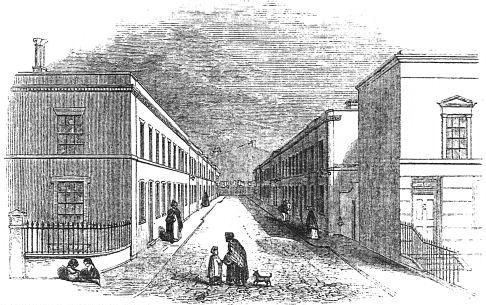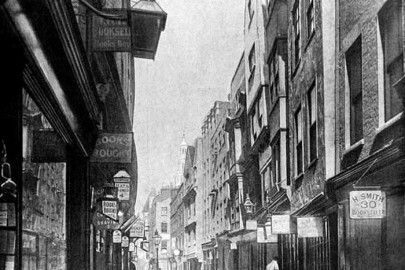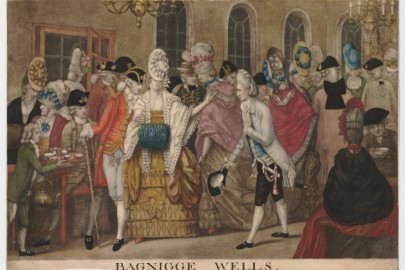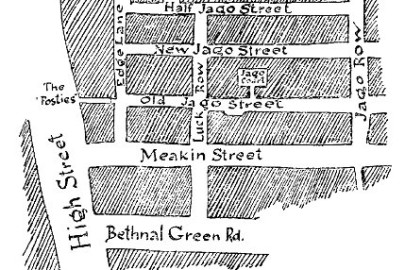Jonathon Green continues his slang tour of London with a look at the chequered history of Black Mary’s Hole…
We have been to Clerkenwell before and here we are again. I shall forswear Pissing Alley, long bowdlerized as Passing Alley but still redolent of the odours that named it; I shall abandon a search for Codpiece Court, even if, as Views of London noted of the latter in 1725, ‘’tis creditably reported, that there is no want of that sort of Work in this Parish.’ Let us turn then to what Views termed ‘the reputable Village called Black Mary’s Hole.’ Reputable usually synonymises respectable; an earlier use means ‘of note’. One may assume that it was that sense that Views, which tended to irony, preferred. And if what follows offers no tangible slang, there was plenty in the air. Views again:
The inhabitants [of Clerkenwell] speak as plain English as those of […] Billingsgate. The Women for the most part , are observ’d to wear black and blue Eyes, with swell’d Faces, […] owing to their too great Volubility of Speech, and the Courtesy of their well-bred Husbands, who are for the most part Butchers, and treat them in the same tender and respectful Manner as they do their other Cattle.
Black Mary’s Hole lay on the bank of the Fleet River, half a mile or so upstream of Turnmill Street. It was also called Black Mary’s Well, which is what the ‘hole’ contained, and Black Mary’s Field was adjacent. The well was popular – its iron-impregnated waters supposedly cured sore eyes – and it was covered and made into a conduit in 1687 and is marked as such, near the Pantheon Turnpike Gate, on Rocque’s map of London (l746-8). A hamlet developed around it, ‘a tiny alienated settlement on the banks of the upper Fleet’, as a latter-day commentator put it. Still rural in 1642, the Common Council had mounted a battery of cannon there, fearing a Royalist attack.
It had a pub, The Fox at Bay, which appears to have been a hangout for local villains. The Hole appears regularly in Old Bailey records, a site for highway robbery. Thus the case of Richard Tobin, indicted in 1739 ‘for assaulting Michael Crosby , in a certain Field and open Place, near the King’s Highway, putting him in Fear, &c.’ Fearful, perhaps, victim, definitely not:
As I was coming last Sunday Night from Black Mary’s Hole, the Prisoner overtook us in the first Field we pass’d over, and turning upon me he gave me a Jolt. I asked him, What he wanted? And he ask’d me, What I wanted? I told him, I wanted nothing but Civility; upon that he held up this Iron Bar to me, and said, – d—mn you, you Dog, deliver your Money this Moment, or else I will kill you: I put my Hand in my Pocket to give him my Money; but I was the longer in delivering it, because I was thrusting my Watch into my Breeches, when I had done that, I deliver’d him all my Money, which was 9 s. and 4 d. then he snatch’d off my Hat and Wig; but the Wig falling, and he stooping to take it up, I fell upon him, and beat him, and got the better of him. While I had him upon the Ground, I held him down with one Hand, and with the other I unty’d his Garter, and bound him.
Tobin mounted the deadly nevergreen before the year was out.
It was also among the first noted gay cruising grounds. In 1705 the salacious ‘newspaper’ The Wandering Spy, mentioned ‘that Sink and Sodom of the Town, the famous Black Mary’s Hole’. In 1731, one David Hall was tried as a ‘molly’ for stripping, robbing and then kissing John Hart, who had been ‘much in Liquor’ at the time. Nor should we forget a piece of contemporary, punning porn, A Voyage to Lethe. By Captain Samuel Cock, sometime Commander of the Good Ship Charming Polly . Dedicated to the Right Worshipful Adam Cock, Esq., of Black Mary’s Hole, Coney Skin Merchant.
So why Black Mary? The Gentleman’s Magazine of 1813, in an ‘Account of the Various Mineral Waters around London’ lists ‘the spring or conduit on the eastern side of the road leading from Clerken Well to Bagnigge Wells, and which has given name to a very few houses as ‘Black Mary’s Hole’. The land here was, formerly, called Bagnigg Marsh, from the river Bagnigg, which passes through it. But, in after-time, the citizens resorting to drink the waters of the conduit, which was then leased to one Mary, who kept a black cow, whose milk the gentlemen and ladies drank mixed with the waters of the Conduit, from whence, the wits of the age used to say, “Come let us go to Black Mary’s hole”.’
But, continues the Magazine, ‘This etymon is contested in a pamphlet called An experimental enquiry concerning the Contents, Qualities, Medicinal Virtues of the two Mineral Waters of Bagnigge Wells &c. (1767): “A tradition goes that the place of old was called Blessed Mary’s Well, but that the name of the Holy Virgin having, in some measure, fallen into disrepute during the Reformation, the title was altered to Black Mary’s Well, then to Black Mary’s Hole; though there is a very different account of these latter appellations; for there are those who insist they were taken from one Mary Woolaston, whose occupation was attending at a well, now covered in, by the footway from Bagnigge to Islington to supply the soldiery, encamped in the adjacent fields, with water”.’
And was Black Mary black? Notes and Queries (1886) ponders the religious aspect – possibly an order of ‘Black Virgins’, i.e. nuns – has no time for the cow: ‘a pleasant fiction’, but offers a 1761 reference to a ‘Blackmoor woman’, one Mary, living on site in a circular stone hut around 1730. Was that Ms Woolaston? Far from impossible. An ex-servant, perhaps. There were plenty of black servants, imported from the Caribbean, in 18th century London.
Nothing lasts, even mysterious wells. By the late 18th century the area was being built over and it had been covered by the new street, Spring’s Place. The well became a cesspool. Forgotten until 1826 it only reasserted itself when the pavement collapsed and the now stinking chasm revealed. Repairs were made and the Hole vanished once more. It now lies beneath a council estate.
However, if the mood beckons, you can dance it, ‘Black Mary’s Hole’ or ‘Black Mary’s Hornpipe’ was published in 1735 in Walsh’s Third Collection of Lancashire Jiggs, Hornpipes, Joaks etc., a book that the compiler reveamped that year as The Compleat Country Dancing Master.
I offer the pertinent figures. A Mullinet, no signs in the OED, sounds like a French moulinet, a little mill, and presumably involves whirling.
Hands across all round and back, including Mullinet
Figure of 8 (Whole figure) (x2)
Turn, 2 dancers, by one or two hands (x5)
Lead down the middle and back
Turn, 2 dancers, by one or two hands
Lead down the middle and back
Turn, 2 dancers, by one or two hands
Stamping, clapping hands and snapping the fingers is considered mandatory.













excellent as ever! Black Mary’s Hole is in the area behind the mount pleasant sorting office as far as I’m aware, roughly calthorpe street to the greys inn rd, still a very lost part of London
Michael Crosby is my kind of guy,
Worm, I was going to ask JG where this was in today’s geography – yes, that is a strangely stranded area.
Interesting that Black Mary was reputed to water her milk down. The late Alan Watkins reckoned the foundation of a number of London Welsh dairying fortunes lay not in milk but in the illicitly mixed water.
‘Fox at Bay’: great name for a pub where villains gather.